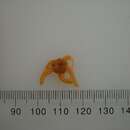en
names in breadcrumbs


“Ophiacantha rosea sp. nov.
Plate X. Figs. 267, 268.
Special Marks. — Disk-scales and radial shields hidden by a thick skin, which is closely beset with very short, stout spines, which sometimes are no higher than grains. Eleven arm-spines, slightly rough under microscope.
Description of an Individual (Station 308). —Diameter of disk 17 mm. Length of arm, 68 mm. Width of arms without spines 4.5 mm. Mouth-papillae irregular; there are usually five on the inner part of the angle, flattened and blunt; and outside these, near end of mouth-slit, a group of from three to six irregular papillae, short and flattened. Eight or nine teeth, shaped like blunt spear-heads. Mouth-shields and side mouth-shields closely joined and covered with thick skin, so that their outlines are not clear. Under arm-plates shield-shaped, with an angle within, a curve without, and reentering curves on the lateral sides opposite the large tentacle-scales. Upper arm-plates with distinct outlines, broad fan-shaped, with a rounded or very obtuse angle inward. Side arm-plates, near base of arm, barely meeting above and below, and having a narrow projecting spine-ridge. Disk puffed, densely and evenly beset, with very short, stout, conical spines, which to the naked eye seem nearly like large grains; scales and radial shields entirely covered. Eleven stout, blunt, regular, cylindrical arm-spines, which, under the microscope, are slightly rough. Lengths to that of an arm-joint 3.5, 4.7, 4, 3.8, 3.8, 2.8, 2.5, 2.5, 2.5, 1.2. .8: 1.3. One very large, thick, pointed tentacle-scale, over 1 mm. long. Color in alcohol, pale rose-pink above; below yellowish.
Specimen from the distant station 145 differed only in having larger spines on the disk. A young one, with a disk of 7 mm. had only seven mouthpapillae to each angle; the additional papillae at the outer end of mouth-slit had not yet appeared; the disk-spines were forked and thorny, and the eight arm-spines were rough and almost thorny.
Station 145, 310 fathoms, 8 specimens. Station 308, 175 fathoms, 12 + specimens. Station 236, 420 – 775 fathoms, 1 specimen.”
(Lyman, 1878; 139)